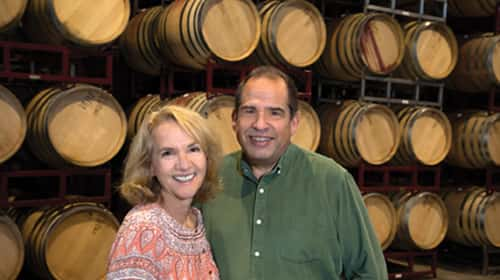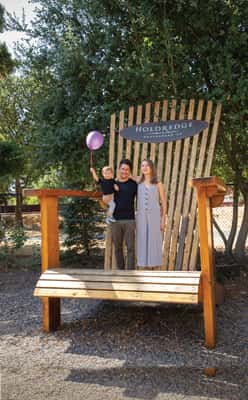By definition, John Holdredge is a winemaker. But to hear him tell it, that’s not a perfect description. Rather, he simply allows his harvest to reach its full potential, which is rooted in its own unique part of the earth and has a distinct voice.
“If you trusted what you felt and what you tasted in the vineyard, the wine is going to be absolutely wonderful,” says Holdredge, who works almost exclusively with Pinot Noir. “Let it be what it wants to be. The struggle is to do as little as possible while not ignoring the wines.” Or, in other words, “In the music of wine, Mother Nature is the rock star. The winemakers are the roadies. And I am totally cool with being a roadie.”
 Holdredge Wines works with 14 vineyards to make distinct Pinot, but initially, he focused on Zinfandel and Syrah. After Saralee Kunde sold Holdredge 5 tons of Pinot grapes in 2001, however, Holderedge’s winery, and his life, changed forever.
Holdredge Wines works with 14 vineyards to make distinct Pinot, but initially, he focused on Zinfandel and Syrah. After Saralee Kunde sold Holdredge 5 tons of Pinot grapes in 2001, however, Holderedge’s winery, and his life, changed forever.
Holdredge, in turn, changed the game plan for this edition of Great Tastes, offering seven of his 14 Pinots from 2018 freshly moved from barrel to tank, waiting to be bottled. It was a flavorful tour of Sonoma County, all without leaving the cool confines of Holdredge Wine’s distinctive big red barn on Front Street in Healdsburg, which serves as winery and tasting room—with pours from a bottle on most days.
First, Holdredge offers a taste of his Saralee’s Vineyard Pinot Noir, sourced from the land that sparked his passion for Pinot 19 years ago. The Kundes sold the vineyard to Jackson Family Wines in 2012, and Holdredge says he’s fortunate the Jacksons continue to sell him grapes from this special place on the east side of the Russian River. It already possesses lush flavors of red fruit and has a lavish mouthfeel. “Eight, 10 years down the road, the nuance, the subtlety that comes out of that vineyard is stunning,” he says.
Next, we head to the Sonoma coast for two stops and begin with Pinot Noir from Martinelli Three Sisters Vineyard in Fort Ross-Seaview. “The place is so incredibly raw and rugged.” The Pinot it produces smells of crushed flowers and unfurls richness across the palate. Holdredge guides the tour north, to Annapolis Campbell Ranch. Dubbed “The True” because it’s true Sonoma coast, this wine’s fruit comes from plush ground that yields a drink with fine tannin, good weight and is intensely floral and savory. “This is Stone Temple Pilots plush. But the acoustic version,” he says, referencing the soft but heart pounding alternative rock hit from the ’90s.

After the coastal experience, we traverse to Westside Road in Healdsburg, near the Russian River. First, Holdredge recalls Bucher Vineyard, where he’s had some very serene moments. “You feel the breeze, you hear the hawk, that sort of thing.” Holdredge says the vineyard often shows aromatic notes of rose petal. This year, there’s an intriguing dark rose petal note. Second stop on Westside Road: Rochioli Vineyards. The Pinot from this vineyard has more grip from fine tannins, and Holdredge doesn’t get in the way. “It’s a different voice—confidence in who it is and where it’s going—this vineyard ages wonderfully.”
Taste No. 6 is the winery’s Sonoma Coast Blend, derived from five high-elevation sites, from Freestone to Annapolis. John’s wife, Carri, who has a superior palate according to Holdredge, makes the final call in blending trials for this wine. Its flavor profile contains notes of black and red licorice, macerated strawberries and ripe red raspberries.
The tour ends in Santa Rosa, at Benovia’s Martaella vineyard on Piner Road. This Pinot earned the name, Petits Cadeaux, or “little gifts” due to the small clusters of grapes it’s made from. “More skin, less juice. Skin’s where everything good is.” As with all of these vintages still in tank, this wine is already fit to drink with a satisfying flavor.
John Holdredge’s winemaking journey took an unexpected turn in 2001, and he was placed on a righteous path. His love for the vineyards drives his passion. “At the end of the day, it has everything to do with the journey and listening to Mother Nature,” he says. “You walk the vineyard, you hear the voice and ultimately, you hope to release a wine that you interfered with so little that the expression of the wine is similar to what you felt. That’s the best part of winemaking.”




